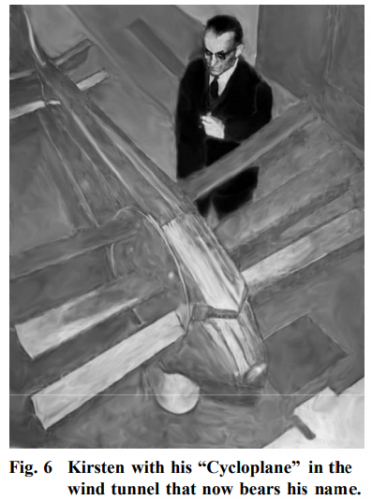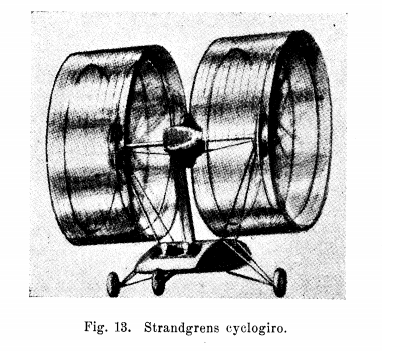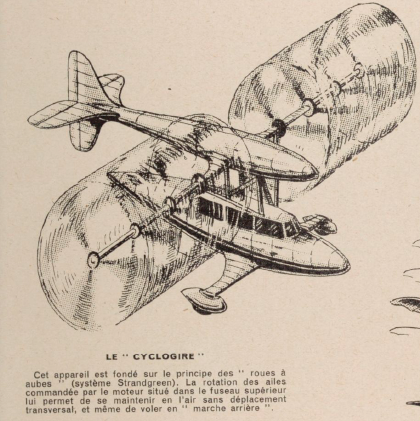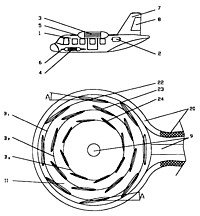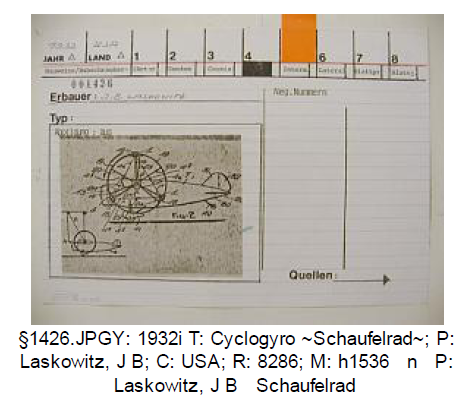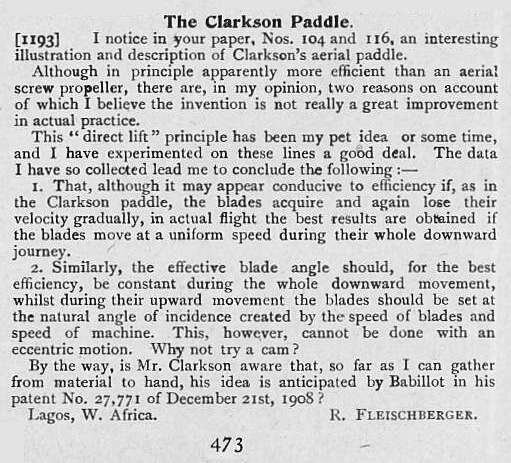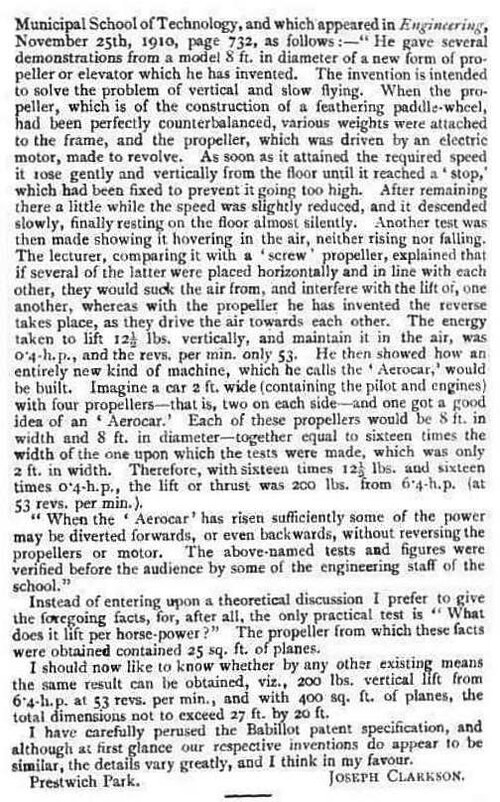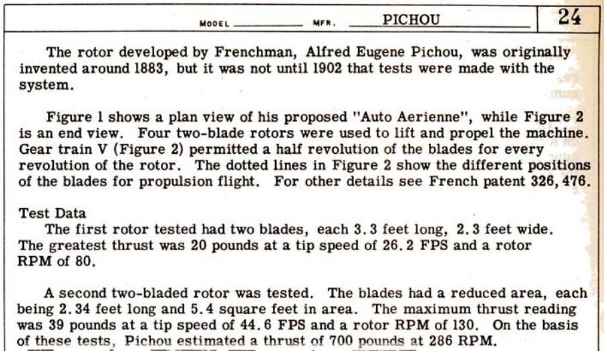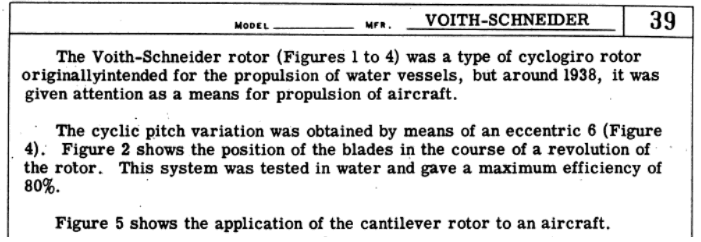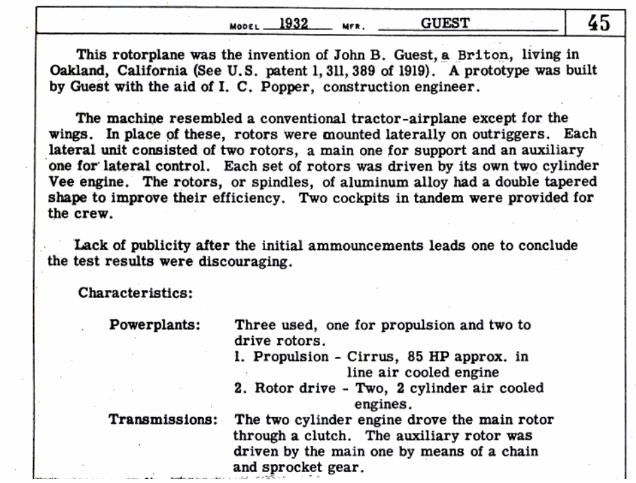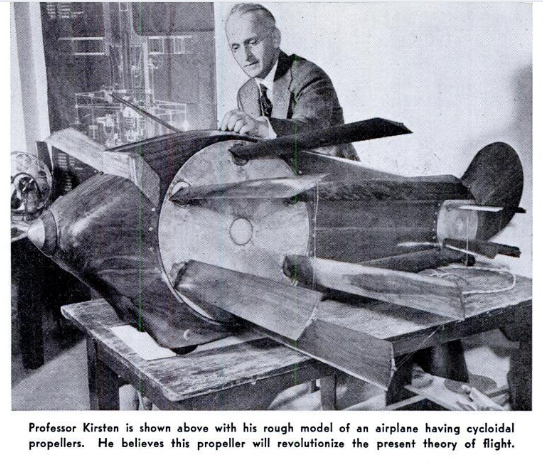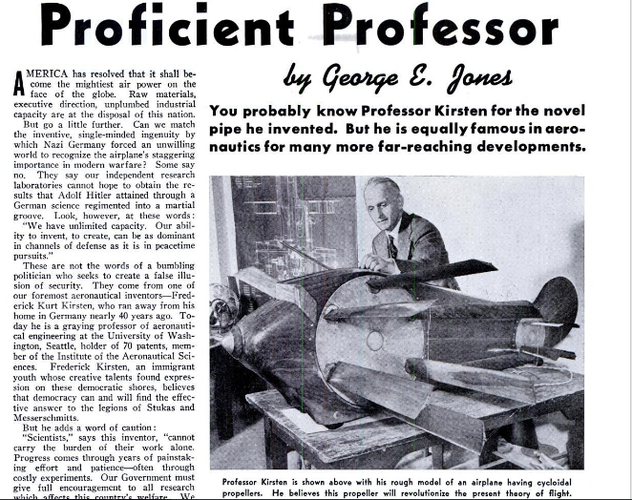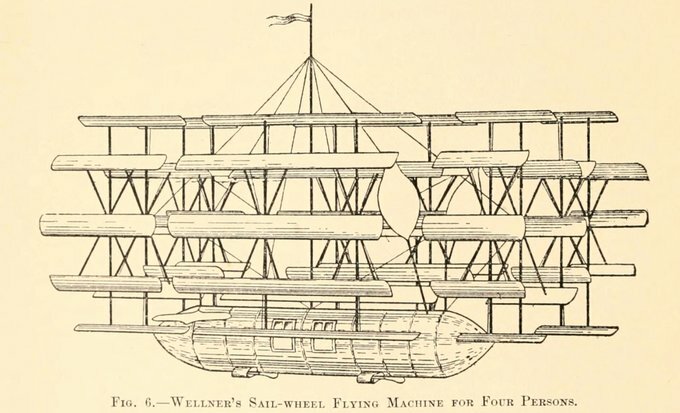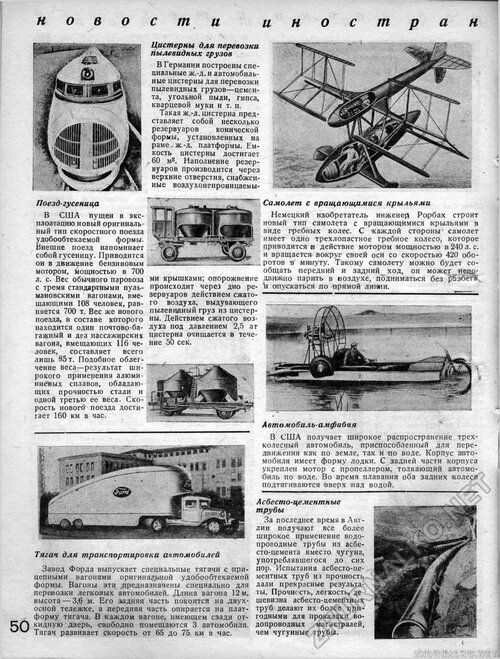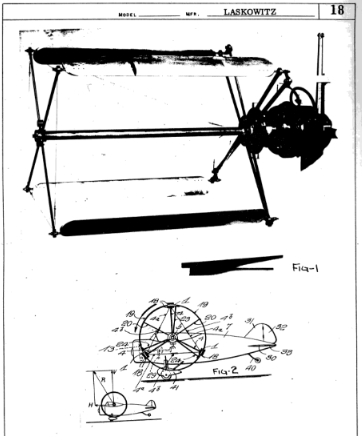You are using an out of date browser. It may not display this or other websites correctly.
You should upgrade or use an alternative browser.
You should upgrade or use an alternative browser.
Cyclogyros Aircraft
- Thread starter hesham
- Start date
- Joined
- 26 May 2006
- Messages
- 34,828
- Reaction score
- 15,707
Hi,
also Mr. B. Lakowitz designed a cyclogyro in 1932.
http://kulturserver-nds.de/home/hubtest/medien/Typenkartei3953xGUN7x9T3Z7.pdf
also Mr. B. Lakowitz designed a cyclogyro in 1932.
http://kulturserver-nds.de/home/hubtest/medien/Typenkartei3953xGUN7x9T3Z7.pdf
Attachments
- Joined
- 26 May 2006
- Messages
- 34,828
- Reaction score
- 15,707
Hi,
Sverchkov's Samoljot, St-Peterburg, 1909.
This craft was called "Samoljot", but it had also another name — "wheel orthopter". Its scheme came near to cyclogiro, but it's difficult to classify it precisely. It had three flat surfaces and a rudder; rear edge of one of surfaces could be bent, replacing the action of an elevator. Lift and thrust had to be created by paddle wheels consisting of 12 blades, established in pairs under a 120° angle. The blades of a concave shape were changing an angle of incidence by the means of eccentrics and springs. In a bottom of the craft 10 hp Bushe engine was arranged, from which the belt transmission was running. The three-wheel undercarriage was made droppable and was intended for takeoff only. Fabric-covered framework was made of thin-wall steel tubes and bamboo trunks with steel strings inside. Empty weight was about 200 kg. "Samoljot" was constructed by the military engineer E.P.Sverchkov with the grants of the Main Engineering Agency in St.Petersburg in 1909, was demonstrated at the Newest Inventions Exhibition and won a medal. But the tests have passed unsuccessfully: it not only has not come off ground, but even has not moved from a place.
The famous Russian inventor and scientist, engineer-electrician A.N.Lodygin in 1914 has addressed to Russian government with the project of the cyclogiro-like aircraft, which scheme was similar to Sverchkov's "Samoljot". The project was not carried out.
It is interesting to note, that in 1935 the famous German designer A.Rohrbach has acted with the rather similar cyclogiro project, which was published in aviation magazines.
Sverchkov's Samoljot, St-Peterburg, 1909.
This craft was called "Samoljot", but it had also another name — "wheel orthopter". Its scheme came near to cyclogiro, but it's difficult to classify it precisely. It had three flat surfaces and a rudder; rear edge of one of surfaces could be bent, replacing the action of an elevator. Lift and thrust had to be created by paddle wheels consisting of 12 blades, established in pairs under a 120° angle. The blades of a concave shape were changing an angle of incidence by the means of eccentrics and springs. In a bottom of the craft 10 hp Bushe engine was arranged, from which the belt transmission was running. The three-wheel undercarriage was made droppable and was intended for takeoff only. Fabric-covered framework was made of thin-wall steel tubes and bamboo trunks with steel strings inside. Empty weight was about 200 kg. "Samoljot" was constructed by the military engineer E.P.Sverchkov with the grants of the Main Engineering Agency in St.Petersburg in 1909, was demonstrated at the Newest Inventions Exhibition and won a medal. But the tests have passed unsuccessfully: it not only has not come off ground, but even has not moved from a place.
The famous Russian inventor and scientist, engineer-electrician A.N.Lodygin in 1914 has addressed to Russian government with the project of the cyclogiro-like aircraft, which scheme was similar to Sverchkov's "Samoljot". The project was not carried out.
It is interesting to note, that in 1935 the famous German designer A.Rohrbach has acted with the rather similar cyclogiro project, which was published in aviation magazines.
Attachments
- Joined
- 26 May 2006
- Messages
- 34,828
- Reaction score
- 15,707
In Russia,
and from 1914 to 1916,three designers created a Cyclogyro Projects,Mr. Alexander Nikolaevich Lodygin,
Mr. A.G. Mikhailov and Mr. A.K. Medvedev.
the story for Medvedev;
A.K.Medvedev has addressed to Military Department with the offer to carry out "paddle wheel". His wheel was consisted of a steel box with four attached blades. The box received rotary movement from the engine and oscillatory movement - from the air pump. The change of an axis movement was made on 1/8 move of a box, and 3/8 move the axis should be in rest, only rotating together with a box. Such a paddle wheel, on an idea of the inventor, had to replace the action of a propeller. The department of the inventions of Military-Industrial Committee, having considered this project, has recognized it "low-practical" and has informed Medvedev, that does not assume to use his offer.
- Joined
- 26 May 2006
- Messages
- 34,828
- Reaction score
- 15,707
and here is the Strandgren project;
http://gallica.bnf.fr/ark:/12148/bpt6k6554756t/f36.image.r=L'Aerophile.langFR
Hi,
Attachments
- Joined
- 26 May 2006
- Messages
- 34,828
- Reaction score
- 15,707
- Joined
- 26 May 2006
- Messages
- 34,828
- Reaction score
- 15,707
Anther Cyclogyro design.

Airwheel Plane, Paddle Wheel Boat - Science And Mechanics (Jan, 1934)
MANY attempts have been made, both before and after the invention of the airplane, to develop a craft which should really fly. The ornithopter, or bird-wing craft, has not been successful in its motion, any more than mechanical devices which simulate walking. The bird, like the man, has a great...blog.modernmechanix.com
The name of the designer is still unknown ?.
And from L'Air Revue 1939.
Attachments
- Joined
- 26 May 2006
- Messages
- 34,828
- Reaction score
- 15,707
Attachments
- Joined
- 19 October 2012
- Messages
- 1,980
- Reaction score
- 1,931
Well Hesham perhaps looking at the caption to the illustration would give you a clue. It says Strandgren Airwheel, and a quick Google search on his name will show you he was Carl Bruno Strandgren. There are several patents in his name.The name of the designer is still unknown ?.
- Joined
- 26 May 2006
- Messages
- 34,828
- Reaction score
- 15,707
Thank you my dears Schneiderman and Richard,
also here is anther patents for some cyclogyros,from Rahn,Servanty and Tsepenyuk;
also here is anther patents for some cyclogyros,from Rahn,Servanty and Tsepenyuk;
Attachments
- Joined
- 26 May 2006
- Messages
- 34,828
- Reaction score
- 15,707
- Joined
- 26 May 2006
- Messages
- 34,828
- Reaction score
- 15,707
Hi,
Mr. Laskowitz which we spoke about him before in invention a helicopters,he also designed a cyclogyro in 1932.
http://kulturserver-nds.de/home/hubtest/medien/Typenkartei3953xGUN7x9T3Z7.pdf
Mr. Laskowitz which we spoke about him before in invention a helicopters,he also designed a cyclogyro in 1932.
http://kulturserver-nds.de/home/hubtest/medien/Typenkartei3953xGUN7x9T3Z7.pdf
Attachments
Last edited:
- Joined
- 26 May 2006
- Messages
- 34,828
- Reaction score
- 15,707
In reply # 102,
I displayed this Project,and it was a paddle wheel,but I don't know the designer,it was Mr. Gavin,
maybe this one;
http://kulturserver-nds.de/home/hubtest/medien/Typenkartei3953xGUN7x9T3Z7.pdf
I displayed this Project,and it was a paddle wheel,but I don't know the designer,it was Mr. Gavin,
maybe this one;
http://kulturserver-nds.de/home/hubtest/medien/Typenkartei3953xGUN7x9T3Z7.pdf
Attachments
- Joined
- 26 May 2006
- Messages
- 34,828
- Reaction score
- 15,707
Attachments
- Joined
- 26 May 2006
- Messages
- 34,828
- Reaction score
- 15,707
a hint for Mr. Irvine cyclogyro of 1910,did we speak
about it here ?.
Attachments
- Joined
- 26 May 2006
- Messages
- 34,828
- Reaction score
- 15,707
From, Special Types of Rotary Wing Aircraft,
Mr. Clarkson 1910.
Mr. Clarkson 1910.
Attachments
- Joined
- 26 May 2006
- Messages
- 34,828
- Reaction score
- 15,707
From, Special Types of Rotary Wing Aircraft.Hi,
here is a paddle-wheels design of 1912,made by French Mr. Alfred Pichou,maybe remained a Project only.
Aerophile 1912
French Airecraft Before The Great War
Attachments
- Joined
- 26 May 2006
- Messages
- 34,828
- Reaction score
- 15,707
.....and if you take one, and stick it in water, it's called a "Voight-Schneider Propeller" (sometimes spelled "Voith-Schneider"):
Regards,
Thomas L. Nielsen
Denmark
From, Special Types of Rotary Wing Aircraft.
Attachments
- Joined
- 26 May 2006
- Messages
- 34,828
- Reaction score
- 15,707
From, Special Types of Rotary Wing Aircraft,Mr. L. Rüb cyclogyro,page 25;
Attachments
richard B
ACCESS: Secret
- Joined
- 17 August 2006
- Messages
- 343
- Reaction score
- 498
L. Rüb cyclogyro
This picture is from post #36 :
(Modell of the Schaufelrad-Tragdeckflüglers von Ludwig Rüb at the Zeppelin Museum Friedrichshafen .)

The story , in German , and its English Google traduction :

 www.schule-bw.de
www.schule-bw.de
The Rüb case -
the first aircraft manufacturer on Lake Constance
Between 1899 and 1902 Ludwig Rüb tried his hand at building a paddle wheel airplane in Friedrichshafen based on his ideas. The financial support from Graf Zeppelin regulated in a contract is its earliest verifiable connection with a specific aircraft project. In addition, Rüb was the first aircraft manufacturer on Lake Constance.
In addition to working on his aircraft, Rüb was also involved in building a propeller boat that was used to develop efficient propellers for Graf Zeppelin's airships.
With the then very substantial sum of around 30,000 marks, Rüb in Friedrichshafen had used three times more for his flying machine project than he had estimated himself. The construction of a test setup in Manzell, with which he was supposed to prove the feasibility, brought him to the limits of his technical possibilities. Only individual parts of the aircraft were built, the mysterious "Rüb aircraft" was miles away from completion when the collaboration with Graf Zeppelin was terminated on April 4, 1902.
This picture is from post #36 :
(Modell of the Schaufelrad-Tragdeckflüglers von Ludwig Rüb at the Zeppelin Museum Friedrichshafen .)
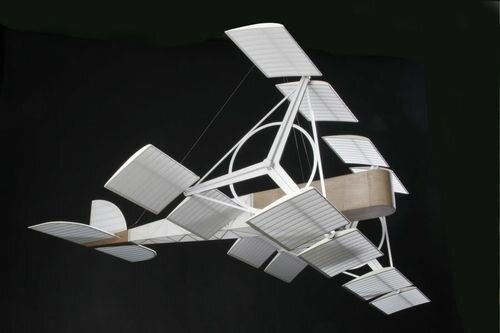
The story , in German , and its English Google traduction :

Ludwig Rüb
Der Landesbildungsserver (LBS) Baden-Württemberg ist mit derzeit 2.200.000 Seitenansichten im Monat und seiner Fülle an Materialien einer der größten Bildungsserver in Deutschland.
The Rüb case -
the first aircraft manufacturer on Lake Constance
Between 1899 and 1902 Ludwig Rüb tried his hand at building a paddle wheel airplane in Friedrichshafen based on his ideas. The financial support from Graf Zeppelin regulated in a contract is its earliest verifiable connection with a specific aircraft project. In addition, Rüb was the first aircraft manufacturer on Lake Constance.
In addition to working on his aircraft, Rüb was also involved in building a propeller boat that was used to develop efficient propellers for Graf Zeppelin's airships.
With the then very substantial sum of around 30,000 marks, Rüb in Friedrichshafen had used three times more for his flying machine project than he had estimated himself. The construction of a test setup in Manzell, with which he was supposed to prove the feasibility, brought him to the limits of his technical possibilities. Only individual parts of the aircraft were built, the mysterious "Rüb aircraft" was miles away from completion when the collaboration with Graf Zeppelin was terminated on April 4, 1902.
richard B
ACCESS: Secret
- Joined
- 17 August 2006
- Messages
- 343
- Reaction score
- 498
Looking at my files , I have three first names for Herr Rüb : Ludwig , Wilhelm and Otto ...
This "Otto , Ludwig , Wilhelm" could be (probably) the same as Ludwig Rüb who built a big biplane in Ulm in 1911...I keep searching ...
Later , in 1917 , his sons Emil and Ludwig Rudolf built a co-axial helicopter , the Rotoplan II .
In 1922 Ludwig Rudolf Rüb had a patent for an airplane without propeller .
This "Otto , Ludwig , Wilhelm" could be (probably) the same as Ludwig Rüb who built a big biplane in Ulm in 1911...I keep searching ...
Later , in 1917 , his sons Emil and Ludwig Rudolf built a co-axial helicopter , the Rotoplan II .
In 1922 Ludwig Rudolf Rüb had a patent for an airplane without propeller .
strange, as far as I can see no mentioning of the company Cyclotech from Linz, Austria:

 www.cyclotech.at
www.cyclotech.at
applications:

 www.cyclotech.at
www.cyclotech.at

Also a Airtaxi concept can be found on the webpage.
Not sure how viable this concept is, but they are working since ~15years on the technology, see history at the website under "company".

A Revolutionary Propulsion System in Aviation | CycloTech
Combining Benefits of Rotorcraft and Fixed-Wing Concepts | VTOL and agility of manoeuvrability | Higher efficiency in forward flight| patented technology
applications:

Air Taxis and Drones | New Propulsion Solutions | CycloTech
Revolutionary propulsion technology | Limitless possibilities for urban air mobility | Compound propulsion solutions | Environmentally friendly

Also a Airtaxi concept can be found on the webpage.
Not sure how viable this concept is, but they are working since ~15years on the technology, see history at the website under "company".
- Joined
- 26 May 2006
- Messages
- 34,828
- Reaction score
- 15,707
From, Special Types of Rotary Wing Aircraft,
he was called Mr. John B. Guest.
Attachments
mekon
ACCESS: Restricted
- Joined
- 7 January 2009
- Messages
- 8
- Reaction score
- 9
Hi all,
I wonder if Prof. G. Wellner's "Sail-Wheel Flying Machine" designs, circa 1895, are the first examples of a cyclogyro concept..?
(from https://archive.org/details/popularsciencemo46newy/page/631/mode/1up)
I wonder if Prof. G. Wellner's "Sail-Wheel Flying Machine" designs, circa 1895, are the first examples of a cyclogyro concept..?
(from https://archive.org/details/popularsciencemo46newy/page/631/mode/1up)
Attachments
- Joined
- 26 May 2006
- Messages
- 34,828
- Reaction score
- 15,707
Attachments
On Titan, perhaps that could double as a rover.
Paddlewheel in liquid, roll…fly.
Armin Derer
In dire need for coffee
- Joined
- 10 June 2021
- Messages
- 70
- Reaction score
- 99
Schaufelrad is the type of propulsion (" Lifting rotor ") , and Ernst Zenzem (or Zeuzem?) is the designer .
These pages are from Modern Mechanix 2/1931. The name of the craft is Rotor Airship.

Choppers, helos, веÑÑÐ¾Ð»ÐµÑ (850) â Rotor Airship (1931) & Random clippings, random news (1.413) â Modern Mechanix 2/1931
A source for accurate historical information and news about rotary wing flight and flying machines plus an endless stream of helicopter themed entertainment, products, literature, art and film
As for the name of the designer one can be relatively sure that it is Zeuzem, for in Popular Mechanics 1/1931 there is another spindle plane by Zeuzem, where the name is clearly visible on a model shown in the article (Rotor-Zeusem). I assume that an editor might bungle up the name in copy, but the designer may be able to correctly spell his own name when he applies it to a drawing of his doing.

Choppers, helos, веÑÑÐ¾Ð»ÐµÑ (1.005) & Ernst Zeuzem Walzenflugzeug & Random clippings, random news (1.751) â Popular Mechanics 1/1931
A source of accurate historical information and news about rotary wing flight and flying machines plus an endless stream of helicopter themed entertai
As for the names of these more exotic types of rotorcraft, here is an endless mix-up.
The types w/ cylindric barrel- or drum-like „wings“ are often labelled paddle-wheels, where in fact they are spindle planes or Walzenflügel (German for barrel- or drum-wing).
Paddle wheels (Paddel- or Schaufelrad) are those like – in the olden days – the Gray Goose (https://helikopterhysteriezwo.blogspot.com/2017/06/choppers-helos-302-utopian-helicopters.html) or the modern day model cyclogyros like the one flown in 2008 in Singapure (https://helikopterhysteriezwo.blogspot.com/2017/06/choppers-helos-330-cyclogyro-modell-der.html).
Where the spindle planes (or drum-wings) work after the Magnus- or Coanda-effect, the paddle wheels operate after the principle of the Voith-Schneider-Rotor.
Adding to the confusion is the term cyclogyro, which basically both these types are labelled throughout. What I gathered from all these old magazine reads is that those early designers threw fancy words like helicoplane or cyclogyro or paddle-wheel at their contraptions, to name them, not to acurately describe a physical principle or a clearly defined type of craft.
Also I now realize that Jemiba has deconstructed most of this already further up this thread.
Last edited:
Armin Derer
In dire need for coffee
- Joined
- 10 June 2021
- Messages
- 70
- Reaction score
- 99
we spoke about this site before,but they can't ID this one.
Do not despair, my dear Hesham, nobody can identify it, and nobody ever will, for this is MOAPW, the Mother Of All Paddle-Wheels, also sometimes whispered of as the Great Unknown Contraption.
Last edited:
Who stole my combine?
- Joined
- 26 May 2006
- Messages
- 34,828
- Reaction score
- 15,707
Hi,
Mr. Laskowitz which we spoke about him before in invention a helicopters,he also designed a cyclogyro in 1932.
http://kulturserver-nds.de/home/hubtest/medien/Typenkartei3953xGUN7x9T3Z7.pdf
From, Special Types of Rotary Wing Aircraft,

